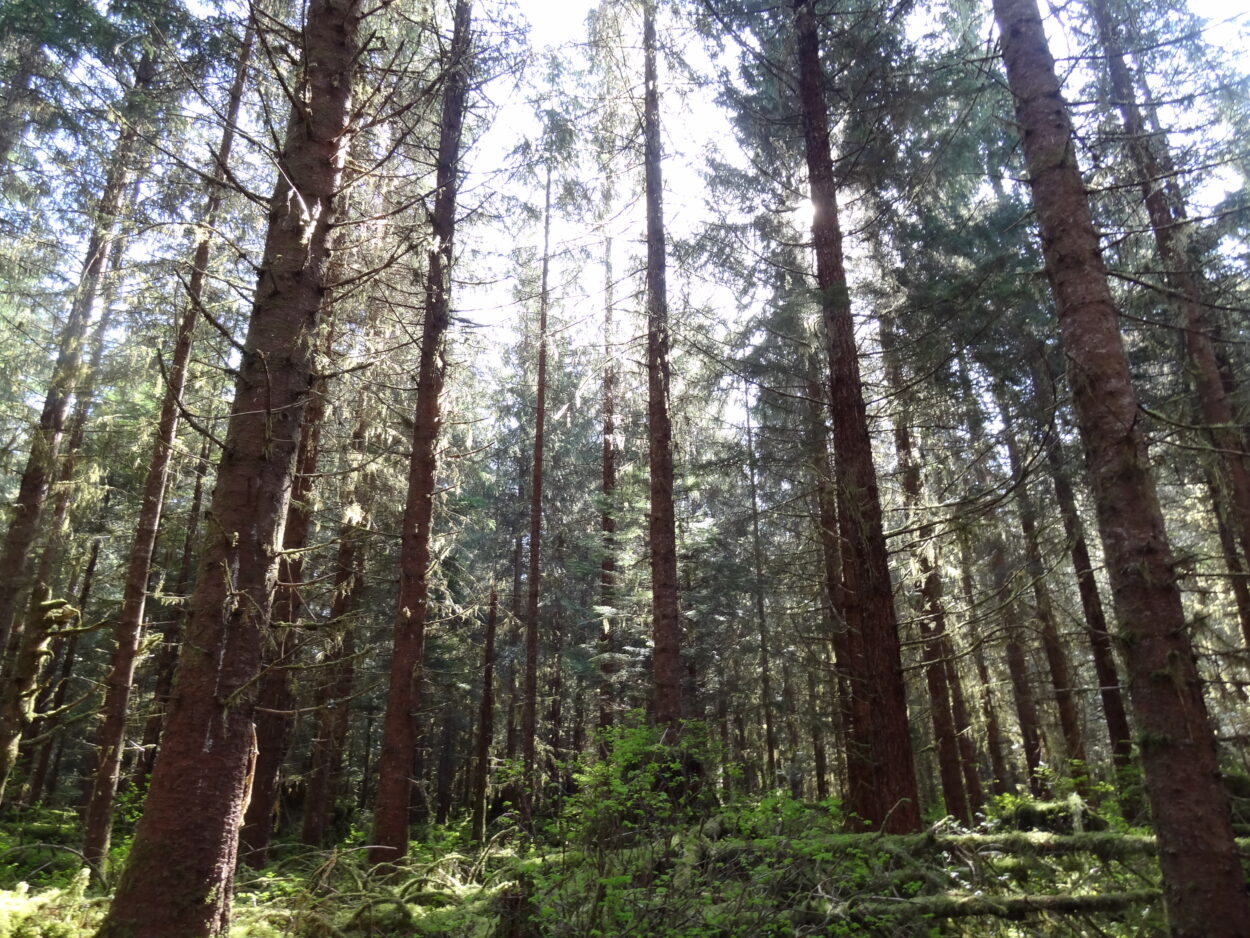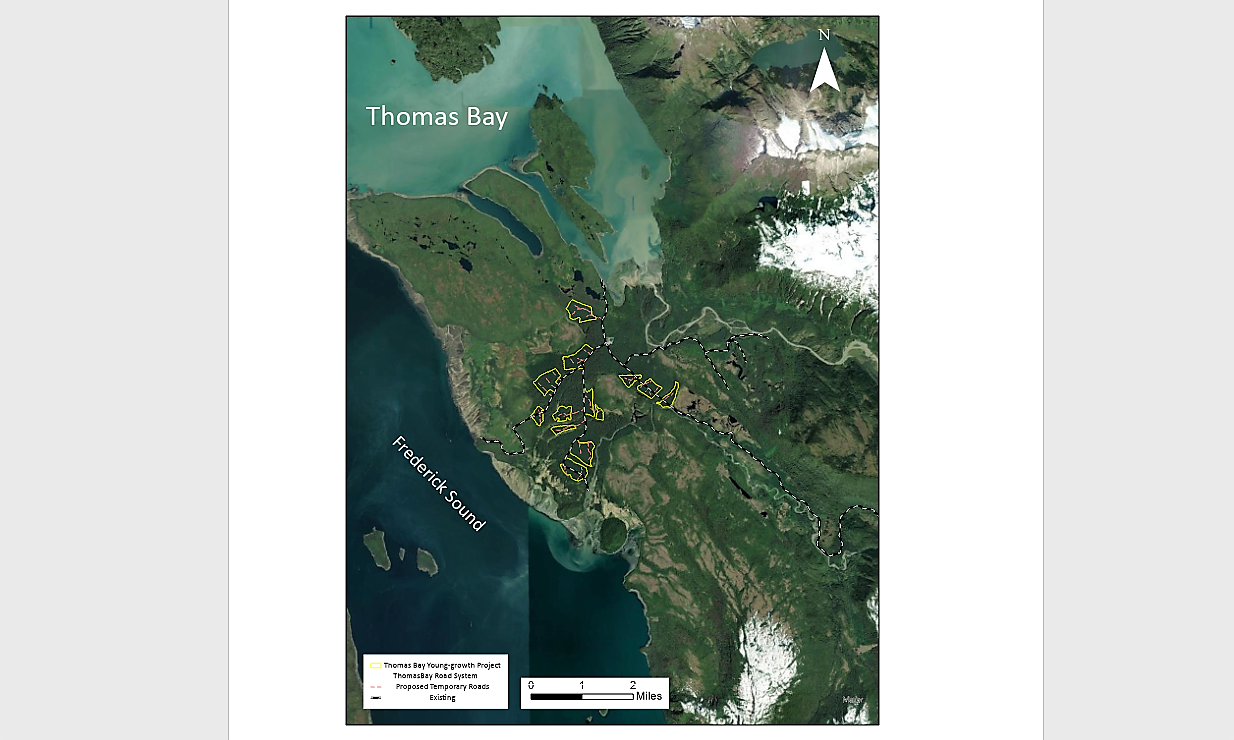
The U.S. Forest Service is proposing a young growth timber sale near Thomas Bay in Southeast Alaska that’s seeing opposition from environmental groups. As Angela Denning reports, its one of the first sales to focus on second growth logging, following a federal plan to stop cutting down old growth trees.
The proposed sale at Thomas Bay could mean logging 22 million board feet of timber from about 840 acres of forest. It would focus on second growth trees that have regrown from logging back in the 1950s and 60s.
“So much has changed since the 1960s,” said Eric LaPrice, Acting District Ranger for the Petersburg Ranger District. He says the previous Thomas Bay logging came before laws restricted how it was done. “So, how areas were harvested in the 50s and 60s, umm, how it’s done today would look nothing like that at all,” he said.
The proposed sale includes smaller plots within the original logged areas. LaPrice says there could be one sale for all of the 800 acres or several smaller sales over a number of years. Either way, it would likely involve clear cutting. But LaPrice says the logging that’s allowed today is much more responsible, taking into account wildlife habitat.
“We would have provisions to retain, for example, a buffer along a stream so it would keep the stream shaded,” LaPrice said.
These days, the forest service assesses the environmental impacts through workers that didn’t exist decades ago: silviculturists, hydrologists, archeologists, and salmon biologists. In the past, areas were clear cut without thought about the regrowth. The forest would regrow pole-like trees too close together to establish limbs or spaces for wildlife. Left alone, it would take hundreds of years to become old growth again, requiring blow downs and other natural developments.
Now, the forest service monitors logged areas and can do restoration treatments like thinning if needed, says LaPrice.
“Right when things are beginning to regrow, that’s the really critical time to monitor that things may be coming back the way we want them too,” he said.

Several environmental groups generally agree that modern regulations have helped prevent environmental damage from logging. Still, several groups like Center for Biological Diversity, Defenders of Wildlife, and the Southeast Alaska Conservation Council (SEACC) are opposed to the Thomas Bay sale as planned. The sticking point for them is the size of the possible clear cutting, which they say is bad for habitat.
“Essentially, it will be clear cut,” said Katie Rooks, Environmental Policy Analyst at SEACC. “The entire area will be harvested using clear cut.”
Rooks says that type of logging doesn’t follow the Southeast Alaska Sustainability Strategy, which the federal government announced last year. That plan looks to “support forest restoration, recreation and resilience.”
In addition, the Forest Service released a plan in 2015 that outlined a transition from old growth to young growth logging. And just weeks ago, on April 22, President Joe Biden signed an executive order to inventory old growth forests.
SEACC wants the Forest Service to stand behind its new plans. The environmental group is proposing some alternatives to the Thomas Bay timber sale that includes breaking it up and offering smaller sales to smaller operators. Rooks says that would be better for the environment and would likely keep the product in Alaska and the Pacific Northwest.
One reason for the timber sale is to restore the area from the old logging. Although most of the sale money would go to the U.S. Treasury some would go to restoration work in the area, including improving old culverts.
“There were roads and trails that were left in from that, that altered drainage patterns, for example,” LaPrice said. “So, we would be looking at opportunities where if there was a drainage pattern that was altered we might want to restore it back to its original water course.”
SEACC is skeptical of restoration as an incentive for the timber sale. Rooks says other logging restoration projects in the region —like culvert work– have proven that it’s too expensive to get it all done just from timber sales.
“There’s always this backlog of things that need to happen,” said Rooks. “Creating more need for that to happen seems problematic.”
Final approval for the Thomas Bay project is at least a few years off. LaPrice says they hope to have the environmental analysis done in 2023.
It’s unknown how much money the timber sale will make for the government. LaPrice says he can’t speculate until the projects are appraised.
There is another smaller proposed timber sale on Mitkof Island that includes one million board feet on 40 acres located along Upper Falls Creek. It’s possible that logging could start there by the end of this year.
LaPrice says they’ve heard from some small Petersburg companies that are interested in both of the timber sales.











